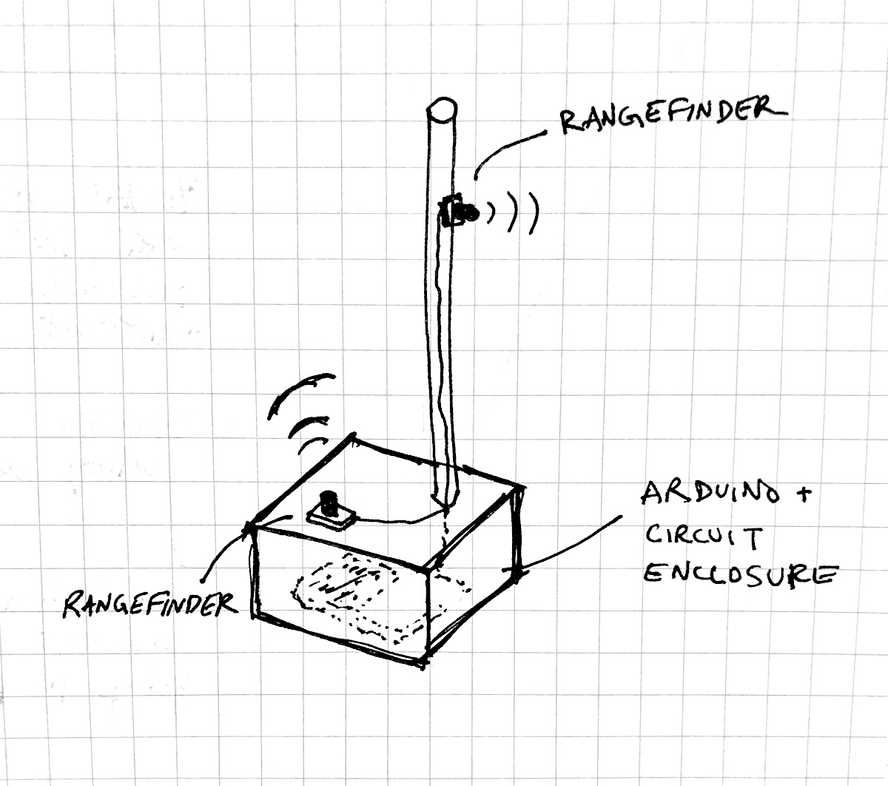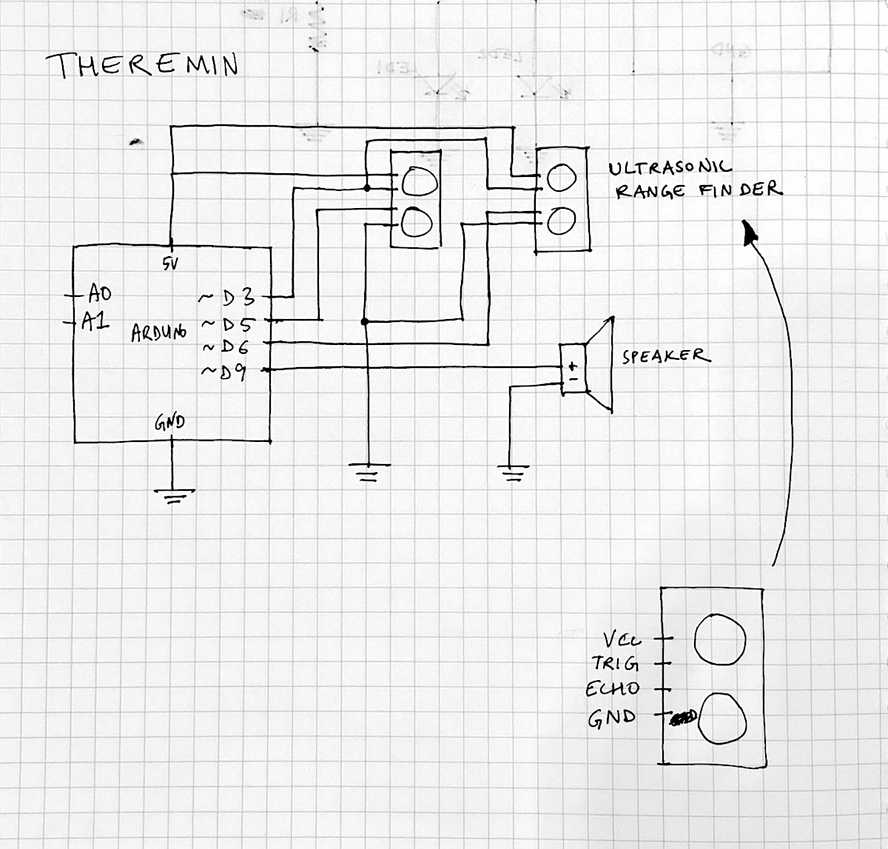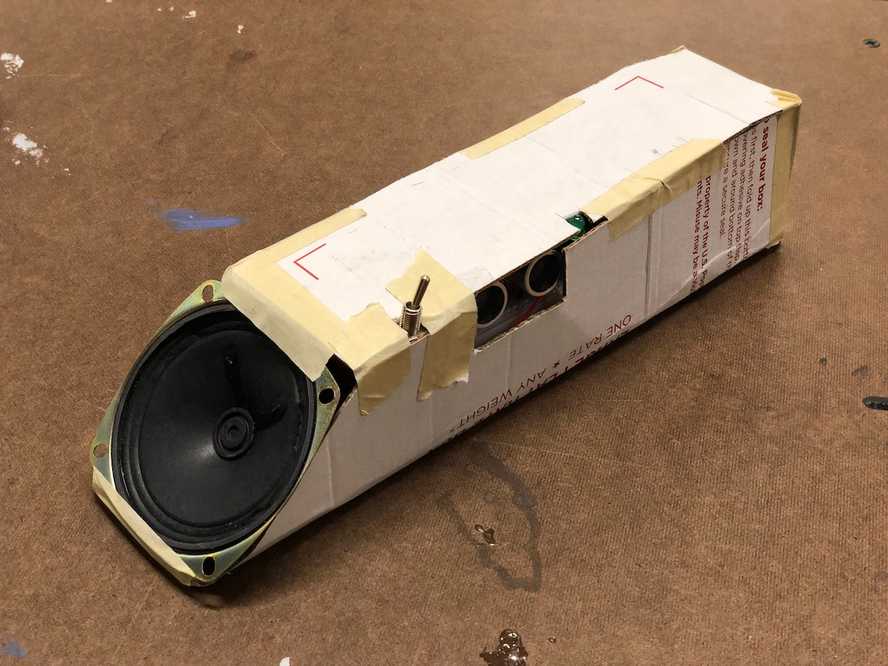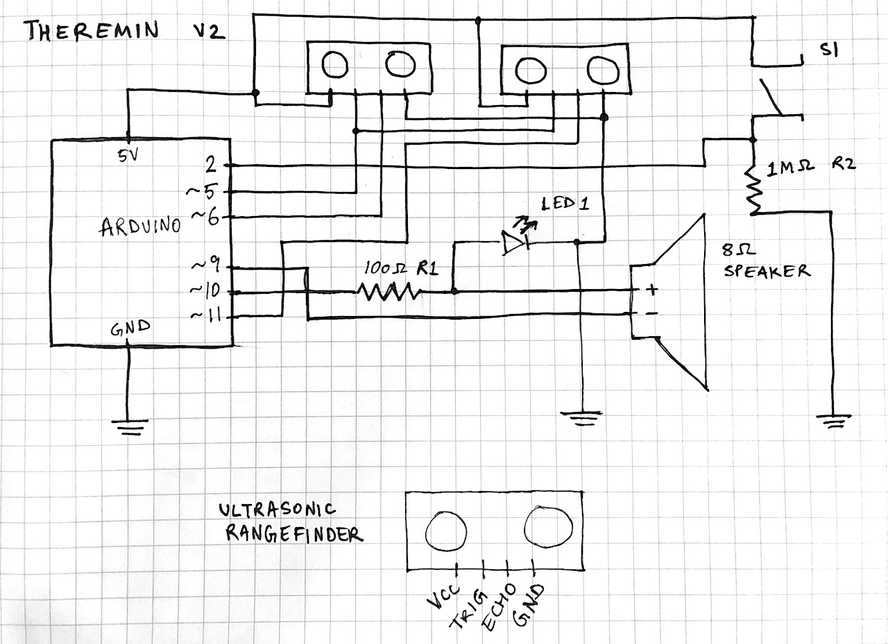ITP blog · physical-computing
Week 4 - simple application
Idea
So far, we've covered the following in the class labs:
- Series and parallel circuits
- LEDs, resistors, variable resistors
- Arduino digital I/O
- Arduino analog I/O
- Audio output with a piezo speaker
- Servo motor control
While browsing the ER parts list, I noticed some IR & ultrasonic distance sensors. So, came up with a plan to make a simple theremin using these sensors and a speaker.
Here's my initial quick sketch of the device:
And here's my initial circuit diagram (digital input from the rangefinders and digital output to the speaker):
Execution
While building the theremin, I decided to change its design to be more compact and portable. It was pretty simple to hook up a 9V battery to the Arduino to allow the device to be portable after uploading my code via the USB cable. After I got the basic instrument features working, I added a switch to toggle the instrument on / off (the Arduino and the overall circuit still stay on all the time, though, since there is no switch for the battery voltage going into the microcontroller). I also added an LED in parallel with the speaker to give rudimentary visual feedback on the operation of the theremin. The LED pulse & brightness changes with the same pattern as the speaker. Finally, I created a basic cardboard enclosure for the circuit, battery, and speaker.
Here is are some short video clips of it in use:
The final circuit diagram ended up looking like this:
Using the rangefinders was relatively straightforward after consulting this tutorial. You initiate the sensor by sending a 2 microsecond "pulse" (switch from HIGH→LOW signal) on the Trigger pin. In my circuit, I wanted to activate both sensors simultaneously, so I used the same output pin for both rangefinders. Distance readings come back on the Echo pin of the sensor and can be read with the built-in function pulseIn().
One tricky part of this project was achieving tone and volume modulation of the speaker. Arduino's built-in functions for tone() don't support volume modulation, so I found a small library that manages to do this called toneAC. This library requires use of digital pins 9 and 10 on the Arduino UNO, which explains part of the circuit layout. The API of the library is pretty simple (I used 3 out of the 4 argument options):
toneAC(frequency, volume, length);
Code
#include <toneAC.h>
int trigPin = 5;
int echo1Pin = 6;
int echo2Pin = 11;
int switchPin = 2;
void setup() {
Serial.begin(9600);
pinMode(trigPin, OUTPUT);
pinMode(echo1Pin, INPUT);
pinMode(echo2Pin, INPUT);
pinMode(switchPin, INPUT);
}
void loop() {
float duration1, distance1, duration2, distance2;
// send a 2 microsecond pulse to start the rangefinders
digitalWrite(trigPin, LOW);
delayMicroseconds(2);
digitalWrite(trigPin, HIGH);
delayMicroseconds(10);
digitalWrite(trigPin, LOW);
// read from the rangefinders
duration1 = pulseIn(echo1Pin, HIGH);
duration2 = pulseIn(echo2Pin, HIGH);
// map range 1 to tone frequency
float toneFrequency = map(duration1, 100, 250, 100, 4000);
// map range 2 to tone volume
float toneVolume = map(duration2, 1200, 100, 0, 10);
// occasionally print sensor values & mapped variables
if (millis() % 3 == 0) {
Serial.print("d1/d2: ");
Serial.print(duration1);
Serial.print(", ");
Serial.print(duration2);
Serial.print(" .... freq/vol: ");
Serial.print(toneFrequency);
Serial.print(", ");
Serial.print(toneVolume);
Serial.println("");
}
if (digitalRead(switchPin) == HIGH) {
toneAC(toneFrequency, toneVolume, 50);
delay(1);
}
}
Future improvements
I used a very basic algorithm for generating tones in this project. In the future, I would like to experiment with other approaches besides a simple map()—I think the instrument could produce a more stable and nice sound if it was more tolerant of small changes in its detected range in each rangefinder. I could achieve this by manually mapping a fixed set of distance ranges to a predetermined range of notes on the chromatic scale.





